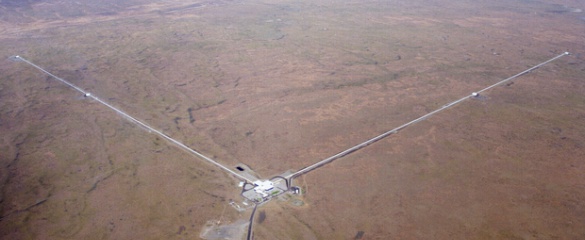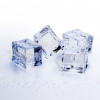 |
|---|
The sooner-than-expected discovery of gravitational waves, announced in February, has given a new impetus to scientists in the field, who are now working to make sense of what it means not only for their research but also for our understanding of Einstein's theory of general relativity.
Imagine two figure skaters on the ice, spiralling in closer and closer toward one another, until they finally form one spinning clump. But you can't see them. Your only clue to their motion is by listening to how the ice subtly cracks and contorts under their movement over the roar of a packed crowd.
That's the sort of challenge scientists are up against when they look for gravitational waves - ripples in the fabric of space which are given off during the merger of pairs of black holes or neutron stars, predicted by Einstein's theory of general relativity.
Gravitational waves are unusual in astronomy, since most of the sources scientists are used to detecting come from the electromagnetic spectrum, whether it is light, radio waves, or gamma rays. Black holes don't emit any such radiation, but the collision of black holes emits energy nonetheless. It turns out to be in the form of gravitational wave energy.
By knowing just what to look for, it's possible to pick up the energy signal of such distant events here on earth billions of years after they happen.
Yet it still came as a bit of a shock when scientists finally detected the first gravitational waves last September at the LIGO observatory in the United States.
'We really weren't expecting for it to be so soon, and we weren't expecting it to be higher-mass binary black hole systems; exactly the thing we were modelling,' said Professor Mark Hannam from Cardiff University, UK, who was involved in the original discovery. 'Now this has all become quite a bit more urgent.'
He leads the BlackHoleMaps project, funded by the EU's European Research Council, which is working out how to better model the different ways that colliding black holes can behave, which is the key to being able to make sense of the gravitational wave signals observatories like LIGO can detect.
'You want to describe these signals and you want to describe them quite accurately, and the only way to tell what they're like is to solve Einstein's equations on a computer,' he explained. 'If you naïvely did it, you'd need tens or thousands of simulations, to describe all possible configurations accurately enough.'
Distinguishing features
To simplify things, he is working with his team to model the most important and distinguishing features that characterise black hole mergers, such as different relative masses between the black holes - if they have a difference in size - or how they are spinning.
The most challenging thing to model has been if the black holes wobble as they orbit one another, a behaviour known as precession. A few years ago, his team made a prototype model for how such precessing black holes behave as they circle one another closer and closer, by working out how to make use of simpler models.
These days, he is working on figuring out exactly what the gravitational wave signal looks like when such wobbling black holes merge. That, in turn, could make it easier to categorise black hole pairs - how many there are, how massive, and how fast do they spin, which could provide insight into how stars and galaxies evolve.
Another way to make signal interpretation easier is to improve the precision with which we can detect gravitational waves on earth.
Observatories like LIGO use multiple-kilometre-length lasers known as an interferometer to detect the minute ripples caused by passing gravitational waves. Such waves shift the laser ever so slightly against a suspended mirror, known as a test mass.
'From position difference of the test mass from one moment to a different moment, we can infer the presence of (the) gravitational wave,' explained Dr Haixing Miao, at the University of Birmingham, UK.
But there is a quantum mechanical limit to how closely you can observe the test mass position in an interferometer, before quantum variations in the laser signal itself start to interfere with the measurement.
In the EU-funded EAGLE project, Dr Miao has found the optimal configuration to reduce such quantum noise in laser interferometers.
One way to reduce noise is to alter the state of light used in the interferometer laser. So-called squeezed light, for instance, can lower quantum noise by reducing the random variations of photons in light. But it's also possible to increase the test mass response to the gravitational waves themselves.
'We can effectively make the test mass behave like a resonator,' Dr Miao explained. 'This is the so-called optical spring effect.' He now hopes to use his findings to recommend improvements to future laser interferometers.
We may have trouble detecting gravitational waves on Earth, but they are actually passing by all the time, and some scientists are trying to identify areas of the universe in which they are most frequent.
Dr Chiara Mingarelli, a Marie Skłodowska-Curie fellow at the German Max Planck Institute who is based at Caltech the US, is using pulsars - rotating neutron stars that emit energy at an extremely stable rate - to detect minute perturbations caused by passing gravitational waves in distant corners of the universe.
Hotspots
As part of the GW ASAP project, she is creating an algorithm to look efficiently for gravitational wave hotspots, a sort of search engine for supermassive black hole pairs that should lay within the signals.
'The gravitational wave isn't strong enough for you to see it as a resolvable single source, but it also doesn't look like a background. So it could be clumpiness, for example. You could have a few sources that are nearby together that just make a large hotspot on the sky,' Dr Mingarelli explained.
Finding such hotspots would be strong evidence that supermassive black holes, billions of times the sun's mass, merge when galaxies collide.
'If we continue expanding out pulsar timing arrays by adding four pulsars per year, we should be able to make a detection in seven to 10 years.'
The biggest result of research into gravitational waves may eventually be overturning Einstein's theories for something new and more precise.
'Einstein's theory of general relativity has survived unchanged for 100 years, and we know there must be something wrong with it somewhere (because it breaks down at the quantum level),' Prof. Hannam said.
'Further down the line, when we get more sensitive detectors, where we will be able to get much, much stronger signals, then we can start to make stronger tests of general relativity.'
- Previous Do we have free will?
- Next The Winter Fortress










Comments
Add a comment